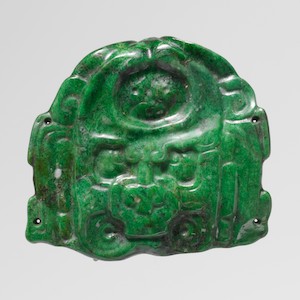Short Teaching Module: Maya Writing
Overview
In the period from 200 to 900 C.E, which scholars later labelled the Classic Period, the Maya developed the most complex writing system in the Americas, a script with nearly a thousand characters (termed “glyphs”) that represent concepts and sounds, which over the last fifty years has been largely deciphered. Classic Maya writing was painted or inscribed with large glyphs in public places where it could be easily seen, on books made of treated tree bark, on dishes and cups, and on smaller objects made of valuable materials designed to be worn or diplayed. Many of the surviving large-scale inscriptions are historical documents recording events in the lives of the Maya kings, queens, and nobles. Others relate to the two cyclical calendars used by the Maya to determine the proper times for religious rituals, one of them cyclical and the other linear. This module includes four examples of Maya writing, one of which led to frenzied claims that the Maya had predicted the end of the world or a great transformation would come December 21, 2012. (Spoiler alert: They hadn’t; it didn’t.)
This short teaching module includes guidance on introducing and discussing the four primary sources.
Essay
Writing began not as a way to record speech, but to record data, such as tallies of days, animals, people, or measures of grain: it was an information technology that later became a communications technology. Writing was invented independently in at least three places—Sumer, China, and Mesoamerica—and perhaps in many more, and it spread from the places it was invented just like any other technology, through conquest, trade, and imitation.
Writing systems—and other forms of information technology—were invented or adopted as a way to organize and run cities that had become too large to administer by word of mouth, and to store, sort, and retrieve information across space and time. Tangible records did not depend on human memory, but were external to the individual; they transcended particular contexts and could be inspected and verified. As cities grew and their populations became more diverse and interdependent, creating and maintaining common and consistent means of measurement, and assigning collective meaning to events and structures, became more important. Conversely, writing also depended on cities, on the high degree of uniformity and control that cities made available, and on the specialization of labor in cities that allowed some individuals to spend time learning to write. Thus urbanization and the development of record-keeping was a process of co-evolution.
In Mesoamerica, the earliest surviving example of writing comes from the Olmecs in around 900 B.C.E., and by about 200 B.C.E. fully developed writing systems were in use in a number of different cities. In the Classic Period—200-900 C.E.—the Maya developed the most complex writing system in the Americas, a script with nearly a thousand characters (termed “glyphs”) that represent concepts and sounds, which over the last fifty years has been largely deciphered. Classic Maya writing was painted or inscribed with large glyphs in public places where it could be easily seen, on books made of treated tree bark, and on smaller objects made of valuable materials designed to be used, worn, or diplayed, such as carved shells, ceramic vessels, hairpins, and jade ornaments, whose value was further enhanced by the artistic quality of the writing. Students learned to write in schools, where they probably began by copying models onto perishable bark and palm leaves.
Many of the surviving large-scale inscriptions are historical documents recording the births, accessions, marriages, wars, and deaths of Maya kings, queens, and nobles counted in a linear fashion forward from a specific date. Others relate to the two cyclical calendars used by the Maya to determine the proper times for religious rituals, one of which they had perhaps inherited from the Olmecs and the other devised through their own careful observation of the earth’s movements around the sun. Such public writing communicated the links between a city’s rulers and the gods even to those who did not read (or who didn’t read very well), so it served as a form of propaganda for public consumption, assuring the city’s residents that the rulers had fulfilled their obligations to the gods.
Primary Sources
Bibliography
Michael D. Coe and Stephen D. Houston, The Maya, 9th ed. London: Thames and Hudson, 2015. An excellent introduction to Maya civilization, designed for students.
Scott A.J. Johnson, Translating Maya Hieroglyphs. Norman: University of Oklahoma Press, 2014. A comprehensive guide that shows readers step-by-step how to translate ancient Maya glyphs
Linda Schele and David A. Freidel. A Forest of Kings: The Untold Story of the Ancient Maya. New York: Morrow, 1990. The story of Maya kingship.
David Stuart. The Order of Days: Unlocking the Secrets of the Ancient Maya. New York: Harmony Books, 2011. A look at the hubbub surrounding 2012 by a foremost scholar of Mesoamerican art and writing, along with a broader consideration of the role that time played in Maya culture.
Credits
Merry Wiesner-Hanks is Distinguished Professor of History at the University of Wisconsin-Milwaukee. She is the long-time senior editor of the Sixteenth Century Journal, an editor of the Journal of Global History, and the editor-in-chief of the nine-volume Cambridge World History (2015). She is an author or editor of more than thirty books and nearly 100 articles that have appeared in English, German, French, Italian, Spanish, Portuguese, Greek, Chinese, Turkish, and Korean.


